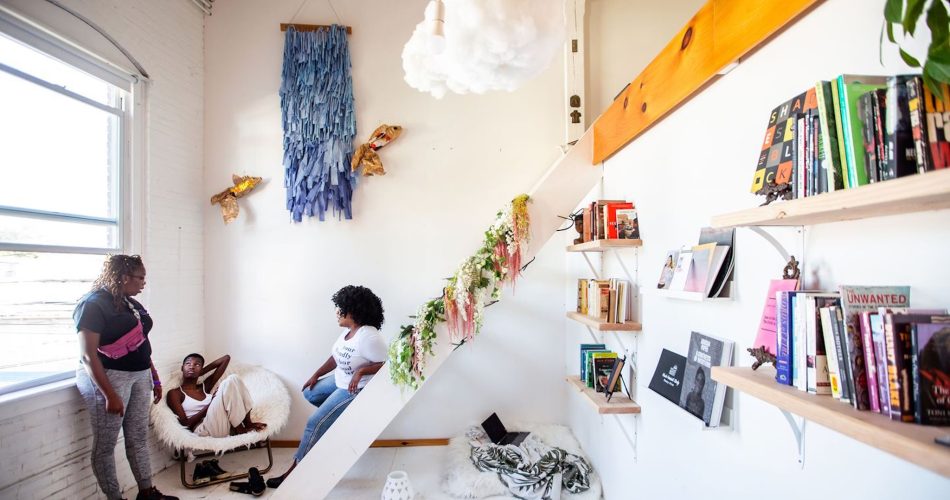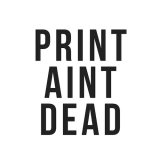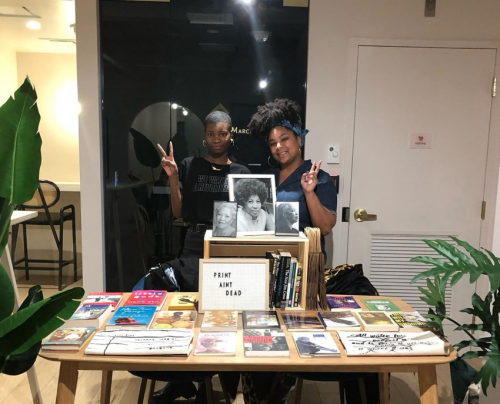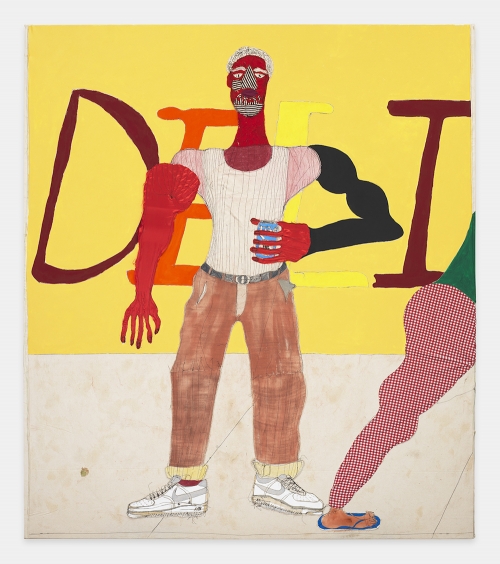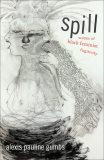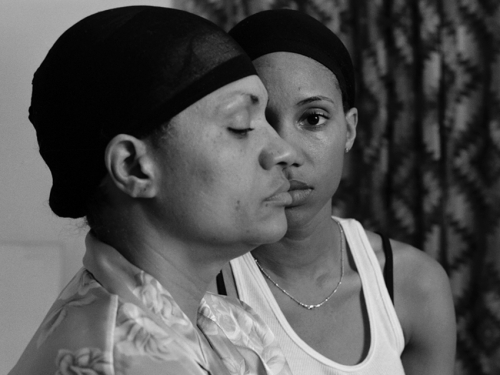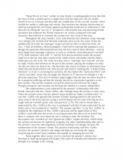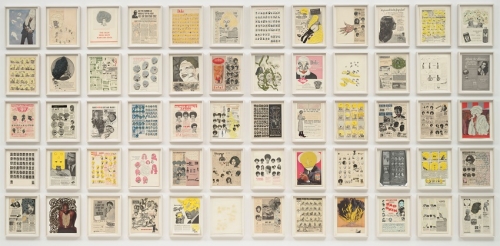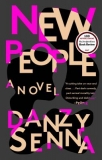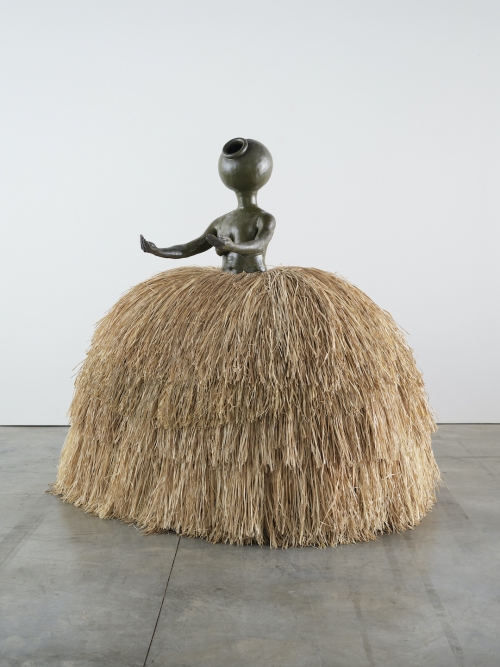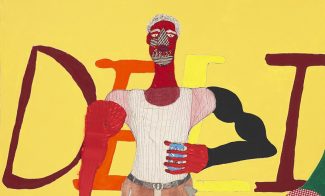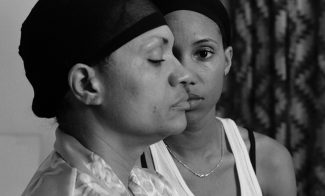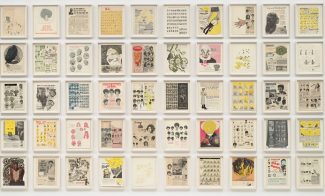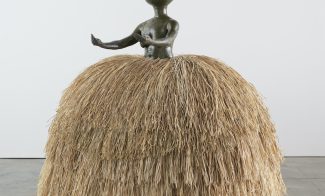Print Ain’t Dead is a bookstore and publishing platform focused on literary and textbased artifacts produced by Black, brown and indigenous artists. To round out Women’s History Month celebrations, the ICA invited Print Ain’t Dead cofounders Cierra Michele Peters and Arielle Gray for reading recommendations inspired by works in the ICA’s collection by Black women artists.
MESSAGE FROM THE CO-FOUNDERS
When we started Print Ain’t Dead in Arielle’s kitchen, we didn’t set out to start a business. In fact, we’re still not a business. Print Ain’t Dead is a proposition. A social sculpture. A publishing platform. Even a non-circulating library. Anything but a business.
We started Print Ain’t Dead because we noticed a problem. Why are there so few bookstores in our neighborhoods? Frugal Bookstore in Nubian Square is our closest option. We launched the project with a pop-up store in Uphams Corner, funded by Design Center for Social Innovation in the Fall 2018. Our intention was to highlight ideas and literary and text-based artifacts produced by black, brown, and indigenous artists. We knew that we were entering a lineage of Black artists, organizers, and writers who understood the power of dialogue, publishing, and documentation. We wanted to build shared space for messy, yet meticulous, dissemination and distribution of new ideas and politics. We were (and still are) attempting to articulate a position informed by radical and transformative behaviors towards our freer selves.
Along with our good friend Jovanna Jones, we also began to run small workshops called the Black Feminist Study Hall. The Black Feminist Study Hall is an exploratory working group grounded in study, citation, and conversation. Last summer, we gathered almost 400 folks in conversation across four workshops.
As Barbara Smith, co-founder of the Combahee River Collective and the founder of the Kitchen Table Press, once expressed, “There is… no guarantee that we or our movement will survive long enough to become safely historical. We must document ourselves now.” As we create space to share formative radical works, we document our histories while pushing our futures forward.
— Cierra Michele Peters and Arielle Gray
In honor of Women’s History Month and in line with our mission of building a space for new ideas and politics, we’ve connected the following works in the ICA Collection by Black women artists with some of our favorite readings:
| Tschabalala Self Lite, 2018 Acrylic, Flashe, milk paint, fabric, and gum on canvas Institute of Contemporary Art/Boston, acquired through the generosity of the Acquisitions Circle, Tristin and Martin Mannion, Rob Larsen, Patrick Planeta and Santiago Varela, and anonymous donors |
“My work is very anecdotal, it’s based on experiences, hearsay even. I want people to feel that they are seen and that they are acknowledged and that they are assured. I want to make something that feels real and truthful—the only thing that can liberate people is the truth.”
—Tschabalala Self for The Art Newspaper
PAIRED READING:
Spill: Scenes of Black Feminist Fugitivity
By Alexis Pauline Gumbs
In Spill, self-described queer Black troublemaker and Black feminist love evangelist Alexis Pauline Gumbs presents a commanding collection of scenes depicting fugitive Black women and girls seeking freedom from gendered violence and racism.
| LaToya Ruby Frazier Momme, 2008 Gelatin silver print Gift of the artist and Michel Rein, Paris/Brussels |
“I believe the answers to making a more equitable and sustainable future in the rustbelt resides in the families and individuals that have endured the greatest hardship. The people of these regions that outside reporters, journalists, commentators, and politicians continue to ignore should not wait for mass media to tell their story. It’s not a matter of vulnerability, it’s a matter of empowerment.”
—LaToya Ruby Frazier for Ebony Magazine
PAIRED READING:
Many Rivers To Cross (Essay)
By June Jordan
“Many Rivers To Cross” is a speech made by June Jordan at a “Women and Work” conference. In the speech, Jordan gives part of her autobiography, starting it off with her mother’s suicide by saying, “When my mother killed herself I was looking for a job.” She later concludes that “new women’s work will mean we will not die trying to stand up: we will live that way: standing up.” The speech in itself tells the story relating to her mother’s suicide, how it affected her, her father, and those around them.
Available to read for free here
| Ellen Gallagher DeLuxe, 2004-2005 Mixed media Gift of Barbara Lee, The Barbara Lee Collection of Art by Women |
“I’ve collected archival material from Black photo journals from 1939 to 1972, looking at magazines like Our World, Sepia, and Ebony. Initially I was attracted to the magazines because the wig advertisements had a grid-like structure that interested me. But as I began looking through them, the wig ads themselves had such a language to them—so worldly—that referred to other countries, Leshiba, this sort of lost past. I started collecting the wig ads themselves. And then I realized that I also had a kind of longing for the other stories, the narratives—wanting to bring them back into the paintings and wanting the paintings to function through the characters of the ads, to function as a kind of chart or a map of this lost world …”
—Ellen Gallagher for Art21
PAIRED READING:
New People
By Danzy Senna
Heartbreaking and darkly comic, New People is a bold and unfettered page-turner that challenges our every assumption about how we define one another, and ourselves.
Available for purchase at local indie bookstores
| Simone Leigh Cupboard IX, 2019 Stoneware, steel, and raffia Acquired through the generosity of Bridgitt and Bruce Evans and Fotene Demoulas and Tom Coté |
“What’s happening with Black artists in the art world in the United States and also globally is more of a correction than a fad or a fashion… and we’re unstoppable now.”
—Simone Leigh for CBS News
PAIRED READING:
Beauty Is a Method (essay)
By Christina Sharpe
“Beauty is not a luxury, rather it is a way of creating possibility in the space of enclosure, a radical act of subsistence, an embrace of our terribleness, a transfiguration of the given. It is a will to adorn, a proclivity for the baroque, and the love of too much.” —Saidiya Hartman
Available to read for free on e-flux
